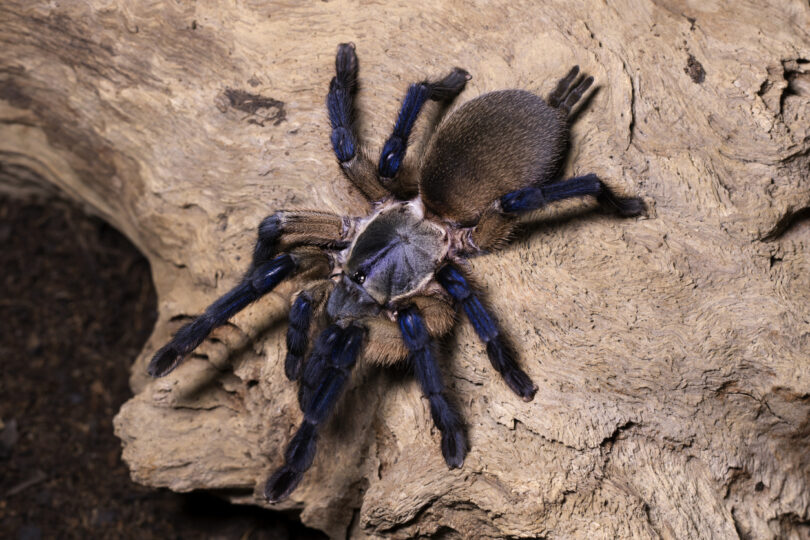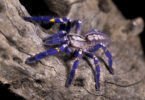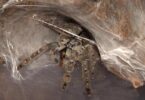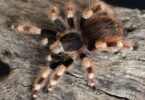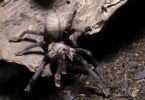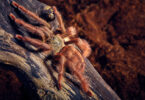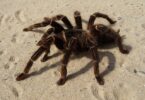Ever felt like your spider collection could use a touch of exotic beauty? Enter the Monocentropus balfouri, a tarantula that’s turning heads with its unique blue and silver coloration. In this post, we’re diving into the world of this captivating arachnid, offering you insights on care, behavior, and why it stands out in the spider enthusiast community.
Get ready to be enchanted by the stunning Socotra Island native—this is one creature tale you won’t want to miss!
Description of the Socotra Island Blue Baboon Spider
Dive into the world of Monocentropus balfouri, a true jewel among spiders with its striking blue legs and golden body—it’s not just your average arachnid! This remarkable species hails from the windswept landscapes of Socotra Island, where it has perfected the art of thriving in isolation and wild beauty.
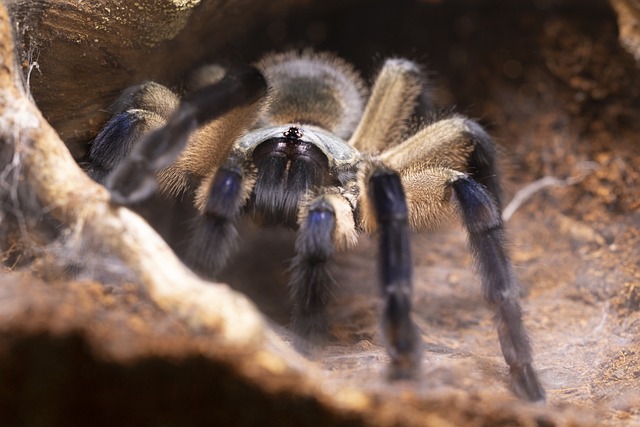
Monocentropus balfouri
Appearance, Size, and Lifespan
This Socotra Island Blue Baboon Tarantula, well, it’s a real looker with its unique blue and grey hues. Can’t miss those colors—talk about standing out in the crowd! These arachnids grow to a mature size of about 16cm of leg span, and guess what? The females are always the big ones; they’re larger than the males.
Yep, that’s right, size matters here!
Now let’s chat longevity—female spiders from this species can stick around for up to 15 years. Males live for about 4 years and die six months after their last molt.
Habitat
Socotra Island, off the coast of Africa, is where the amazing Yemeni Blue Baboon Spider calls home. Picture this: an island with rolling hills reaching up to 850 meters high, surrounded by a vast blue sea—it’s not your average backyard! The ecosystem here? Totally unique.
It’s like nature got creative and made a special spot just for these spiders. They’ve got their pad in dry scrublands or mountain nooks, adapting to life away from typical spider hangouts.
Caring for these eight-legged friends in captivity means playing copycat with their natural digs. You want them happy? Give them a mini-Socotra—a terrarium that mimics what they’re used to on the island.
Think about it—they’ve been living large in a one-of-a-kind habitat; let’s keep that going even when they’re chilling at our places!
Temperament and Venom Potency of Monocentropus balfouri
The Monocentropus balfouri sure is one mysterious spider. Its behavior can be a bit tricky to pin down. On one hand, these blue beauties love to dig and will often hide in their burrows, making cozy homes that they decorate it with a ton of webs.
They’re quite aggressive / defensive too—they’d rather pick a fight than run away if you startle them! if they feel cornered or super threatened, they might just bare their fangs.
Now about that bite—while we’re not exactly sure how strong the venom is for this arachnid, it’s safe to say you wouldn’t want to get nipped by those pearly whites! Being the baboon spider from old world hints that their venom could induce intense muscle pain, sweating, and cramps.
So always handle with care (or maybe just admire from a distance). Oh, and here’s an interesting tidbit: unlike many spiders who’d rather spend time alone, these critters enjoy communal! That’s right; you can keep several M.balfouri together without worrying about any eight-legged tussles over territory—they’re pros at sharing space communally. Just imagine all those little blue legs hanging out like old pals—how cool is that?.
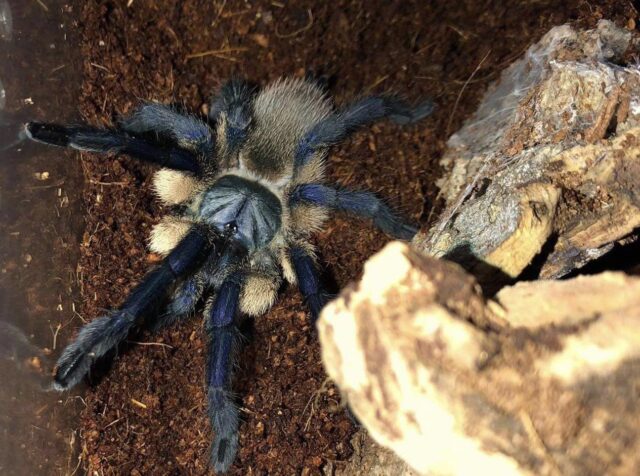
M.balfouri
Enclosure Requirements for Monocentropus balfouri
Ah, the enclosure—where your blue-legged beauty will strut its stuff. For a Monocentropus balfouri, think of it as crafting an island retreat inside your home: a mini Socotra habitat where they can dig, hide, and live their best tarantula life (because who wouldn’t want that?).
Terrarium
So, you’ve got yourself a Monocentropus balfouri and now it’s time to think about where it’s gonna call home, right? A terrestrial terrarium for these blue beauties is like their little piece of paradise, so you want to get it just perfect.
First off—keep the enclosure on the lower side. These spiders don’t need skyscrapers; too high and they might take a tumble that can hurt them.
Place a root or cork tube inside around which it will construct its nest using a substantial amount of web it produces.
Now, let’s talk ground rules: pick a dry substrate. Think sandy deserts rather than tropical jungles. Add in a water dish for sips when thirsty, but no swimming pools needed here! They’re from dry islands after all.
Your spider buddy will enjoy stretching its legs without scaling any dangerous heights. And hey – keep in mind how awesome this is: watching your arachnid friend explore its own slice of Socotra right there in your room!
Humidity and Temperature
Keeping Monocentropus balfouri happy means getting the climate just right in their home. Imagine living where it’s warm but not too hot, kind of like a perfect sunny day. That’s what these spiders love! Aim for temperatures between 76° and 82°F (24.4°-27.8°C) to keep them cozy.
Now let’s talk about moisture – it’s all about balance. These little critters come from dry places, so they’re not fans of soggy feet or air that feels like a wet blanket. Keep the humidity level at a comfortable 60–65%.
Too much water in the air? Nope, they won’t stand for that! Make sure you’ve got this under control because feeling at home is key for our eight-legged friends to thrive!
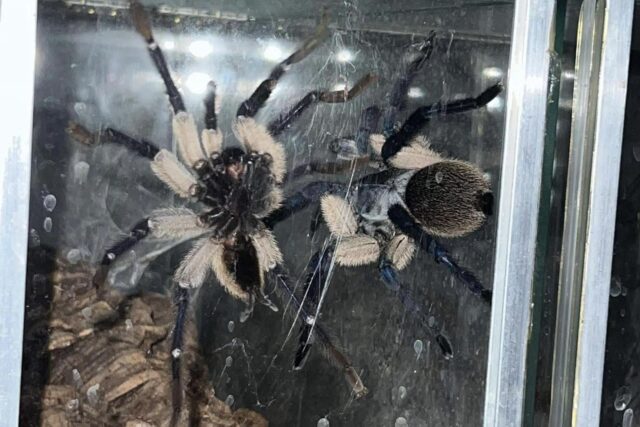
Monocentropus balfouri mating
Conclusion
Alright, let’s wrap this up! The Socotra Island Blue Baboon Spider is not just any ordinary crawler. It’s a stunning creature with a real wow factor – those blue legs are something else! And hey, they even enjoy each other’s company without turning it into a battle royale.
If you’re thinking about making one your eight-legged pal, remember they need a cozy home and the right climate to thrive. So, if you’ve got a love for tarantulas and don’t mind their venomous handshake, this beautiful blue might just be your perfect match!
FAQs
1. How to breed Monocentropus balfouri?
Breeding Monocentropus balfouri is relatively straightforward; we don’t need to manipulate the temperature or humidity in the terrarium. Introduce the adult male to the female for about a month, and the egg sac is typically produced after two months, containing a maximum of 70 eggs. This species has three nymphal development stages, and it’s advisable to leave the young spiders with the female as she tends to them throughout, killing insects and allowing the spiderlings to gather around the prey for communal feeding.
2. Where does this “Blue Baboon Spider” live?
You’ll find the Blue Baboon Spider chilling on Socotra Island—that’s a spot near Yemen.
3. Can i keep Monocentropus balfouri in group?
Yeah, they’re quite the social bunch—surprising for spiders, right? However, zero cannibalism can be achieved only by keeping individuals from the same egg sac together.

